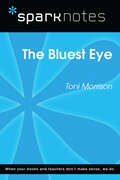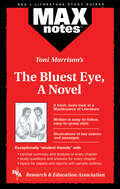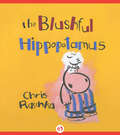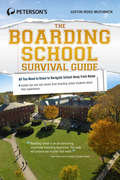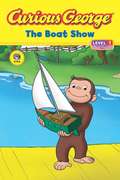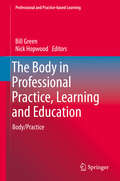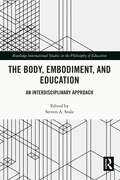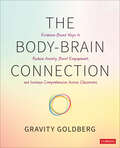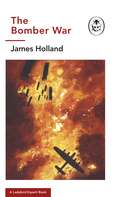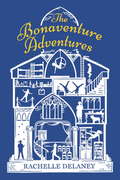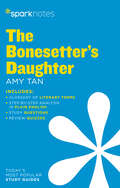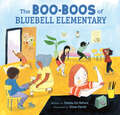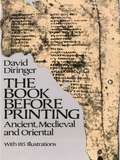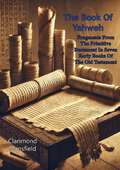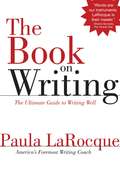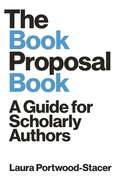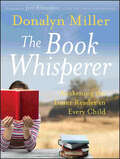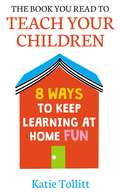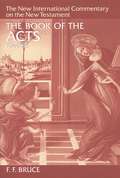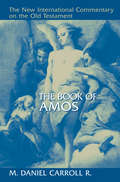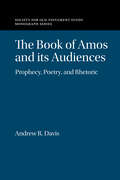- Table View
- List View
The Bluest Eye (SparkNotes Literature Guide Series)
by SparkNotesThe Bluest Eye (SparkNotes Literature Guide) by Toni Morrison Making the reading experience fun! Created by Harvard students for students everywhere, SparkNotes is a new breed of study guide: smarter, better, faster.Geared to what today's students need to know, SparkNotes provides:chapter-by-chapter analysis explanations of key themes, motifs, and symbols a review quiz and essay topics Lively and accessible, these guides are perfect for late-night studying and writing papers.
The Bluest Eye: A Novel
by Christopher HubertREA's MAXnotes for Toni Morrison's The Bluest Eye, A Novel MAXnotes offer a fresh look at masterpieces of literature, presented in a lively and interesting fashion. Written by literary experts who currently teach the subject, MAXnotes will enhance your understanding and enjoyment of the work. MAXnotes are designed to stimulate independent thought about the literary work by raising various issues and thought-provoking ideas and questions. MAXnotes cover the essentials of what one should know about each work, including an overall summary, character lists, an explanation and discussion of the plot, the work's historical context, illustrations to convey the mood of the work, and a biography of the author. Each chapter is individually summarized and analyzed, and has study questions and answers.
The Blushful Hippopotamus
by Chris RaschkaIt's not easy being a blushful hippopotamusBaby hippo Roosevelt tries hard to ride a bike, to count, and to remember the right names of things. When he falls down, forgets a number, or calls a buffalo a "buggalo," Roosevelt gets embarrassed. His cheeks turn red, and his sister teases him, saying he's a blushful hippopotamus. Thankfully, Roosevelt has Lombard, an egret friend with a sense of perspective. Lombard reminds Roosevelt that though he may be blushful, he is also hopeful, thoughtful, and wonderful in many ways--and his sister's words don't mean a thing.
The Boarding School Survival Guide
by Justin Ross MuchnickAttending boarding school is a serious commitment in many realms, whether emotional, financial, academic, or otherwise. With that in mind, it is important to understand what boarding school is all about. This valuable resource is full of insights from students who attend or recently graduated from a boarding school. The Boarding School Survival Guide provides a variety of perspectives that help both prospective students and parents decide if boarding school is the right choice for them, and assists current students in navigating the twists and turns of school away from home. Written by students for students-in a fun, easy-to-read manner with essential, up-to-date information An honest and insightful look at life at today's boarding schools Anecdotal testimonies from current boarding school students and those who've recently graduated Helpful tips and strategies for students who are considering applying to boarding schools or are getting ready to attend one
The Boat Show (Curious George)
by Kate O’SullivanWhen his friend Bill asks George to mind his model boat, George accidentally sinks the boat right before a model boat competition.Experimenting with the buoyancy of his toys, though, George is able to construct another boat that floats. Level one in Houghton's new reader line means that text is minimal and simple, perfect for readers learning to sound out words and looking at art for visual clues.Activities include making a paper boat and experimenting with buoyancy. The audio for this Read-Aloud ebook was produced and engineered by Perry Geyer at Cybersound Recording Studios (349 Newbury St., Ste. 201, Boston, MA 02115). Music theme composed by Cybersound Studios (Perry Geyer, Silvio Amato, Michael Africk, Greg Hawkes). Engineers: Perry Geyer (music production and sound design), Rob Whitaker (editing and mixing engineer), Samuel Creager (editing, sound design, and mixing engineer), Marcus Clark, Corey Rupp. Assistant engineers: Dave Chapman, Mike Pekarski, Justin Sheriff, Daniel Wrigley, Andrew Sardinha, Mami Ienaga, Kevin Notar, Maria Goulamhoussen. Sheridan Willard, John Huang, John Schmidt. Voiceover by Joyce Kulhawik.
The Body Remembers Volume 2: Revolutionizing Trauma Treatment
by Babette RothschildChallenging the notion that clients with PTSD must revisit, review, and process their memories to recover from trauma. The Body Remembers, Volume 2: Revolutionizing Trauma Treatment continues the discussion begun more than fifteen years ago with the publication of the best-selling and beloved The Body Remembers: The Psychophysiology of Trauma and Trauma Treatment. This new book is grounded in the belief that the most important goal for any trauma treatment is to improve the quality of life of the client. Therefore, the first prerequisite is that the client be reliably stable and feel safe in his or her daily life as well as the therapy situation. To accomplish this, Babette Rothschild empowers both therapists and clients by expanding trauma treatment options. For clients who prefer not to review memories, or are unable to do so safely, new and expanded strategies and principles for trauma recovery are presented. And for those who wish to avail themselves of more typical trauma memory work, tools to make trauma memory resolution even safer are included. Being able to monitor and modulate a trauma client’s dysregulated nervous system is one of the practitioner’s best lines of defense against traumatic hyperarousal going amok—risking such consequences as dissociation and decompensation. Rothschild clarifies and simplifies autonomic nervous system (ANS) understanding and observation with her creation of an original full color table that distinguishes six levels of arousal. Included in this table (and the discussion that accompanies it) is a new and essential distinction between trauma-induced hypoarousal and the low arousal that is caused by lethargy or depression. The full color ANS table is also available from W.W. Norton as a laminated desk reference and a wall poster suitable for framing so this valuable therapeutic tool will always be at hand. Principles and theory come alive through multiple demonstration therapy transcripts that illustrate: Stabilizing a new client who consistently dissociates due to persistent trauma flashbacks Clarifying and keeping therapeutic contracts Identifying and implementing hidden somatic resources for stabilization Easing transition from Phase 1 to Phase 2 trauma treatment via trauma memory outlining Utilizing good memories and somatic markers as antidotes to traumatic memory Combining an authoritative yet personal voice, Rothschild gives clinicians the space to recognize where they may have made mistakes—by sharing her own!—as well as a road map toward more effective practice in the future. This book is absolutely essential reading for anyone working with those who have experienced trauma.
The Body in Professional Practice, Learning and Education
by Bill Green Nick HopwoodThe body matters, in practice. How then might we think about the body in our work in and on professional practice, learning and education? What value is there in realising and articulating the notion of the professional practitioner as crucially embodied? Beyond that, what of conceiving of the professional practice field itself as a living corporate body? How is the body implicated in understanding and researching professional practice, learning and education? Body/Practice is an extensive volume dedicated to exploring these and related questions, philosophically and empirically. It constitutes a rare but much needed reframing of scholarship relating to professional practice and its relation with professional learning and professional education more generally. It takes bodies seriously, developing theoretical frameworks, offering detailed analyses from empirical studies, and opening up questions of representation. The book is organized into four parts: I. 'Introducing the Body in Professional Practice, Learning and Education'; II. 'Thinking with the Body in Professional Practice'; III. 'The Body in Question in Health Professional Education and Practice'; IV. 'Concluding Reflections'. It brings together researchers from a range of disciplinary and professional practice fields, including particular reference to Health and Education. Across fifteen chapters, the authors explore a broad range of issues and challenges with regard to corporeality, practice theory and philosophy, and professional education, providing an innovative, coherent and richly informed account of what it means to bring the body back in, with regard to professional education and beyond.
The Body, Embodiment, and Education: An Interdisciplinary Approach (Routledge International Studies in the Philosophy of Education)
by Steven A. StolzNotions of the body and embodiment have become prominent across a number of established discipline areas, like philosophy, sociology, and psychology. While there has been a paradigmatic shift towards this topic, there is a notable gap in the literature as it relates to education and educational research. The Body, Embodiment and Education addresses the gap between embodiment and education by exploring conceptualisations of the body and embodiment from interdisciplinary perspectives. With contributions from international experts in philosophy, sociology, and psychology, as well as emerging areas in related fields, such as embodied cognition, neuroscience, cognitive science, this book sets a new research agenda in education and educational research. Each chapter makes a case for expanding the field and adds to the call for further exploration. The Body, Embodiment and Education will be of great interest to academics, researchers and postgraduate students who are interested in the body and embodiment and/or its relationship with education or educational research.
The Body-Brain Connection: Evidence-Based Ways to Reduce Anxiety, Boost Engagement, and Increase Comprehension Across Classrooms
by Gravity GoldbergEmbrace movement, big and small, to fuel learning success. Learning happens in our whole bodies, not just in our heads. Movement, both big and small, unconscious and conscious, fuels our success, and yet we don’t often acknowledge the body’s role in learning. In The Body-Brain Connection, author Gravity Goldberg explores the powerful relationship between physical activity and cognitive function. This comprehensive guide delves into evidence-based strategies that can help reduce anxiety, boost student engagement, and enhance comprehension in all K-12 classrooms. Helpful features guide your learning with: Prime Yourself personal experiences to bring your attention to key ideas in each section Guiding questions to set the purpose for your learning A Look in the Mirror self-reflection feature to encourage application of the material into your own life and teaching practice Summaries of key ideas and practices for each chapter Whether you′re a teacher or school administrator, this innovative book offers valuable tools and techniques to foster a holistic approach to education, ensuring that students thrive both mentally and physically. It’s time we start paying more attention to our bodies to create an environment where we can all feel safer, be more integrated, and be more successful as readers, writers, and thinkers.
The Body-Brain Connection: Evidence-Based Ways to Reduce Anxiety, Boost Engagement, and Increase Comprehension Across Classrooms
by Gravity GoldbergEmbrace movement, big and small, to fuel learning success. Learning happens in our whole bodies, not just in our heads. Movement, both big and small, unconscious and conscious, fuels our success, and yet we don’t often acknowledge the body’s role in learning. In The Body-Brain Connection, author Gravity Goldberg explores the powerful relationship between physical activity and cognitive function. This comprehensive guide delves into evidence-based strategies that can help reduce anxiety, boost student engagement, and enhance comprehension in all K-12 classrooms. Helpful features guide your learning with: Prime Yourself personal experiences to bring your attention to key ideas in each section Guiding questions to set the purpose for your learning A Look in the Mirror self-reflection feature to encourage application of the material into your own life and teaching practice Summaries of key ideas and practices for each chapter Whether you′re a teacher or school administrator, this innovative book offers valuable tools and techniques to foster a holistic approach to education, ensuring that students thrive both mentally and physically. It’s time we start paying more attention to our bodies to create an environment where we can all feel safer, be more integrated, and be more successful as readers, writers, and thinkers.
The Bold Robins
by Sheila Clark-EdmandsThe robin makes a nest. When the robin has eggs, she will put them all in this nest and will sit on the eggs. The eggs hatch. The hatchlings are fed by the mom robin. The hatchlings get big and fly up into the sky. Mom is sad that the robins have gone, but she is glad that the robins will do well in life.
The Bomber War: Book 7 of the Ladybird Expert History of the Second World War (The Ladybird Expert Series #13)
by James HollandPart of the new Ladybird Expert series, The Bomber War is an accessible, insightful and authoritative introduction to the airborne Allied fight against Nazi Germany.- How did aeroplane technology change the theatre of war?- How did the Blitz affect Britain's ability to fight?- How did the Allies finally triumph?DISCOVER how the complex impact of bomber technology shaped the outcome of World War II. From the Blitz to the Battle of the Ruhr, the Bomber War transformed the state of warfare in the twentieth century. GERMANY'S DEADLY TACTICS, THE ALLIES' BRUTAL VICTORYWritten by historian, author and broadcaster James Holland and with immersive illustrations by Keith Burns, THE BOMBER WAR is an accessible and enthralling introduction to these critical battles and their impact on the outcome of World War II.
The Bonaventure Adventures
by Rachelle DelaneyA middle-grade novel for fans of boarding school stories--with a dash of The Mysterious Benedict Society and a splash of Circus Mirandus! Sebastian Konstantinov comes from a long line of talented circus performers. Somehow, however, he has not inherited any of their acrobatic skill: he has no balance, he's afraid of heights, he can't even turn a somersault. But there's one thing he does know: his father's circus, which travels through Eastern Europe, is out of date and is fast running out of money. Seb has a solution, though: if he can somehow get into the Bonaventure Circus School in Montreal, Canada, he might be able to learn something valuable to help his father. Seb secretly writes to the Directrice (an old friend of his father's) and is accepted into the school. All he has to do is convince his father to send him away -- oh, and keep his lack of talent a secret from all his teachers and classmates. Fortunately for him, he befriends two other students, who also don't seem to quite fit in. Seb is not the only one with secrets, it turns out. The school is literally crumbling beneath the feet of its students, and the directrice may be counting on Seb's "talent" to save the day. Can he and his new friends figure out what's really going on in the school that bills itself as the World's Best Circus School?
The Bonesetter's Daughter SparkNotes Literature Guide (SparkNotes Literature Guide Series)
by SparkNotesSimplify studying with this portable literature guide, filled with resources to help you thrive in English class! The Bonesetter&’s Daughter, written by Amy Tan, depicts the fraught relationship between a Chinese immigrant and her American-born daughter. This literature guide includes a complete plot summary and analysis; key themes, motifs, and symbols; explanation of important quotes; suggested essay topics; and a review quiz. Complete Plot Summary and AnalysisKey Facts About the WorkAnalysis of Major CharactersThemes, Motifs, and SymbolsExplanation of Important QuotationsAuthor&’s Historical ContextSuggested Essay Topics25-Question Review Quiz
The Boo-Boos of Bluebell Elementary
by Chelsea Lin WallaceA rollicking read-aloud featuring a wide cast of characters coming to the school nurse for help with their hilariously dramatic bumps, runny noses, and many other colorful complaints!Kids at Bluebell don't feel well—Gus is sad, and Benny fell. Splinters, lice, a paper cut, throw-up, bumps, a hungry gut. Charlee's tooth won't wiggle free!But there's someone to go to—Miss Peatree!The big feelings and minor dilemmas of elementary school are no match for this hilarious, delightful cast of characters and the untiring compassion of Miss Peatree. One after another, students pile into her office to get fixed up—whether they need a Band-Aid for a bumped knee or a solution for a touch of homesickness. Even the principal visits with an urgent paper cut!With irresistible, hilarious rhyme and endlessly lively art, Chelsea Lin Wallace and Alison Farrell showcase the humor of elementary school's many little problems and the gentle good sense that puts everything right.HILARIOUS HUMOR FOR ALL AGES: This genuinely funny picture book for kids will tickle adults, too. It's tongue-in-cheek but genuine, dramatic but keenly felt. Riddled with rhyme and chock-full of humor in every stanza, it's a perfect read-aloud at school, at bedtime, or whenever kids need cheering up on terrible, horrible, no good, very bad days.TIMELESS TOPIC: Classic in sensibility but with fresh, sharp wit, this book touches on a truly universal topic with an authentic voice young readers will recognize and identify with. The children's struggles immediately capture the drama of feeling sick without being scary. CELEBRATING SELF-CARE: In celebrating the ups and downs of potentially scary situations—feeling sick or getting injured—this book emphasizes the value of sharing emotions and seeing oneself through life's various difficulties. GREAT BOOK FOR CLASSROOM LIBRARY: The accessible, easy-to-read, funny text does an excellent job of getting kids to read and enjoy poetry without even noticing it. In addition to sharing this book for its fun school setting, elementary school teachers and librarians can easily use it in connection with poetry units.Perfect for:Read-aloud option for parents, teachers, and librarians looking for funny books for kidsStarting-school or back-to-school book for young readersReassuring book for kids who experience sickness or struggle to get through bad daysFans of humor, children's poetry, and books that celebrate big feelings
The Book Before Printing: Ancient, Medieval and Oriental
by David DiringerIt is probable that the earliest "books" were written on wood or leaves as early as the fourth millennium B.C. These fragile materials, unfortunately, have not come down to us. In their absence, the earliest surviving books are the clay tablets of Mesopotamia, the oldest attributed to c. 3500 B.C. On these ancient clay shards, dense rows of cuneiform script record the seminal writings of mankind: the Gilgamesh epic, Sumerian literary catalogues, Babylonian astrology, Assyrian accounts of the Creation and the Flood, and the Lipit-Ishtar Law-Code (c. 2000 B.C.), predating Hammurabi and the oldest law code in human history.Probably as ancient as the Mesopotamian writings, or nearly so, are Egyptian hieroglyphics. In a sense, it is the papyrus scrolls of the Egyptians -- preserved by that country's hot, dry climate -- that represent the true ancestors of the modern book. As the centuries passed, papyrus slowly gave way to parchment (the prepared skins of animals) as writing material. Indeed, the handwritten parchment or vellum codex is "the book" par excellence of the Middle Ages. Western European book production is only part of the story, and the author is at pains to illuminate the bibliographic contributions of numerous peoples and cultures: Greek and Roman book production, books made in central and southern Asia, the books of Africa, pre-Columbian America, and the Far East -- material that is often not mentioned in Western histories of the book.Based on years of painstaking research and incorporating a wealth of new material and conclusions, the text is enhanced throughout by abundant illustrations -- nearly 200 photographic facsimiles of priceless manuscripts in museums and libraries around the world.
The Book Of Yahweh: Fragments From The Primitive Document In Seven Early Books Of The Old Testament, By An Unknown Genius Of The Ninth Century, B. C (classic Reprint)
by Clarimond MansfieldClarimond Mansfield’s "The Book of Yahweh: Fragments From the Primitive Document in Seven Early Books of the Old Testament" is a scholarly and enlightening exploration of the earliest texts that form the foundation of the Old Testament. This comprehensive work delves into the ancient manuscripts and fragments that provide critical insights into the development and composition of the Hebrew Scriptures.Mansfield meticulously examines the seven early books of the Old Testament, presenting a compelling case for the existence of a primitive document, often referred to as the Yahwist source. Through rigorous analysis and comparison of textual fragments, Mansfield seeks to uncover the original narratives and theological themes that have shaped the faith and identity of the Jewish people."The Book of Yahweh" offers readers a detailed look at the historical, linguistic, and cultural contexts in which these ancient texts were written. Mansfield’s scholarship is marked by a deep understanding of Hebrew language and literature, allowing him to reconstruct the possible form and content of the earliest biblical documents. His work highlights the intricate process of how these texts were compiled, edited, and transmitted over centuries.Central to Mansfield’s study is the exploration of key themes and stories within the Yahwist source, including the creation narratives, the patriarchal histories, and the foundational covenants between Yahweh and His people. By analyzing these fragments, Mansfield provides a richer understanding of the theological and moral messages that have endured through millennia.Clarimond Mansfield’s work stands as a significant contribution to biblical studies, offering fresh perspectives on the ancient texts that continue to inspire and guide countless individuals. "The Book of Yahweh" not only enhances our appreciation of the Old Testament’s rich heritage but also illuminates the enduring quest for understanding the divine through sacred scripture.
The Book On Writing: The Ultimate Guide To Writing Well
by Paula LarocqueYou're going to love the way Paula LaRocque teaches in The Book on Writing. A celebrated writing coach with a sense of humor and a gentle touch, she's also a master writer herself with a long and distinguished career in both teaching and practicing the art of writing. The Book on Writing contains 25 chapters in three sections: A dozen essential but easy-to-apply guidelines to good writing, from the importance of clarity to the value of a conversational tone. Paula LaRocque believes learning is easier and more successful when we are not only told but also shown. So her Book on Writing is chockfull of actual writing examples that supplement and illustrate principles that apply as naturally to fiction as they do to nonfiction. How to tell a story from building suspense, to effective description, to the uses of metaphor and literary devices. Paula LaRocque also deals with the narrative engine and the value of the archetype in plotting and characterization as well as with pace and speed and leveling what she terms the speedbumps in writing. A clear and concise handbook that deals with common problems in grammar, usage, punctuation, and style'the kind of problems that often trouble even wordsmiths. The handbook also debunks pesky language rules that are actually myths. The Book on Writing is one-stop shopping for writers. Read it once, and you'll be a better writer. Read it often, and you'll be among the best.
The Book Proposal Book: A Guide for Scholarly Authors (Skills for Scholars)
by Laura Portwood-StacerA step-by-step guide to crafting a compelling scholarly book proposal—and seeing your book through to successful publicationThe scholarly book proposal may be academia’s most mysterious genre. You have to write one to get published, but most scholars receive no training on how to do so—and you may have never even seen a proposal before you’re expected to produce your own. The Book Proposal Book cuts through the mystery and guides prospective authors step by step through the process of crafting a compelling proposal and pitching it to university presses and other academic publishers.Laura Portwood-Stacer, an experienced developmental editor and publishing consultant for academic authors, shows how to select the right presses to target, identify audiences and competing titles, and write a project description that will grab the attention of editors—breaking the entire process into discrete, manageable tasks. The book features over fifty time-tested tips to make your proposal stand out; sample prospectuses, a letter of inquiry, and a response to reader reports from real authors; optional worksheets and checklists; answers to dozens of the most common questions about the scholarly publishing process; and much, much more.Whether you’re hoping to publish your first book or you’re a seasoned author with an unfinished proposal languishing on your hard drive, The Book Proposal Book provides honest, empathetic, and invaluable advice on how to overcome common sticking points and get your book published. It also shows why, far from being merely a hurdle to clear, a well-conceived proposal can help lead to an outstanding book.
The Book Whisperer
by Jeff Anderson Donalyn MillerDonalyn Miller says she has yet to meet a child she couldn't turn into a reader. No matter how far behind Miller's students might be when they reach her 6th grade classroom, they end up reading an average of 40 to 50 books a year. Miller's unconventional approach dispenses with drills and worksheets that make reading a chore. Instead, she helps students navigate the world of literature and gives them time to read books they pick out themselves. Her love of books and teaching is both infectious and inspiring. The book includes a dynamite list of recommended "kid lit" that helps parents and teachers find the books that students really like to read.
The Book You Read to Teach Your Children: 8 Ways to Keep Learning at Home Fun
by Katie Tollitt"Really useful, positive and reassuring. Just what parents need right now!" Lizzie Loves HealthyAre you worried your child has fallen behind while schools have been closed? Do you want to support your child's learning at home but worry that everyone just ends up stressed and switches off?Could this be doing more harm than good? It's time to let primary school teacher and education influencer Katie Tollitt take the sting out of home learning. Covering eight key principles for how to approach learning in way that maximises fun, and minimises stress, this short accessible book emphasises the need for flexibility, conversation and openness.It will help you ask the right questions and understand how your attitude towards learning impacts your children. Full of practical tips, suggestions and judgment-free advise, it's the closest thing to having a teacher with you at home.
The Book You Read to Teach Your Children: 8 Ways to Keep Learning at Home Fun
by Katie Tollitt"Really useful, positive and reassuring. Just what parents need right now!" Lizzie Loves HealthyAre you worried your child has fallen behind while schools have been closed? Do you want to support your child's learning at home but worry that everyone just ends up stressed and switches off?Could this be doing more harm than good? It's time to let primary school teacher and education influencer Katie Tollitt take the sting out of home learning. Covering eight key principles for how to approach learning in way that maximises fun, and minimises stress, this short accessible book emphasises the need for flexibility, conversation and openness.It will help you ask the right questions and understand how your attitude towards learning impacts your children. Full of practical tips, suggestions and judgment-free advise, it's the closest thing to having a teacher with you at home.
The Book of Acts (New International Commentary on the New Testament (NICNT))
by F. F. Bruce"“. . . undertaken to provide earnest students of the New Testament with an exposition that is thorough and abreast of modern scholarship and at the same time loyal to the Scriptures as the infallible Word of God.”"This statement reflects the underlying purpose of The New International Commentary on the New Testament. Begun in the late 1940s by an international team of New Testament scholars, the NICNT series has become recognized by pastors, students, and scholars alike as a critical yet orthodox commentary marked by solid biblical scholarship within the evangelical Protestant tradition.While based on a thorough study of the Greek text, the commentary introductions and expositions contain a minimum of Greek references. The NICNT authors evaluate significant textual problems and take into account the most important exegetical literature. More technical aspects — such as grammatical, textual, and historical problems — are dealt with in footnotes, special notes, and appendixes.Under the general editorship of three outstanding New Testament scholars — first Ned Stonehouse (Westminster Theological Seminary, Philadelphia), then F. F. Bruce (University of Manchester, England), and now Gordon D. Fee (Regent College, Vancouver, British Columbia) — the NICNT series has continued to develop over the years. In order to keep the commentary “new” and conversant with contemporary scholarship, the NICNT volumes have been — and will be — revised or replaced as necessary.The newer NICNT volumes in particular take into account the role of recent rhetorical and sociological inquiry in elucidating the meaning of the text, and they also exhibit concern for the theology and application of the text. As the NICNT series is ever brought up to date, it will continue to find ongoing usefulness as an established guide to the New Testament text.
The Book of Amos (New International Commentary on the Old Testament (NICOT))
by M. Daniel Carroll R.In this commentary on the book of Amos, Daniel Carroll combines a detailed reading of the Hebrew text with attention to its historical background and current relevance. What makes this volume unique is its special attention to Amos&’s literary features and what they reveal about the book&’s theology and composition. Instead of reconstructing a hypothetical redactional history, this commentary offers a close reading of the canonical form against the backdrop of the eighth century BCE.
The Book of Amos and its Audiences: Prophecy, Poetry, and Rhetoric (Society for Old Testament Study Monographs)
by Andrew R. DavisMany studies of the prophetic books assume that a text's addressee and audience are one and the same. Sometimes this is the case, but some prophetic texts feature multiple addressees who cannot be collapsed into a single setting. In this book Andrew R. Davis examines examples of multiple addressees within the book of Amos and argues that they force us to expand our understanding of prophetic audiences. Drawing insight from studies of poetic address in other disciplines, Davis distinguishes between the addressee within the text and the actual audience outside the text. He combines in-depth poetic analysis with historical inquiry and shows the ways that the prophetic discourse of the book of Amos is triangulated among multiple audiences.
